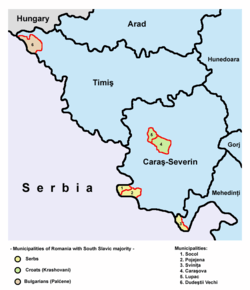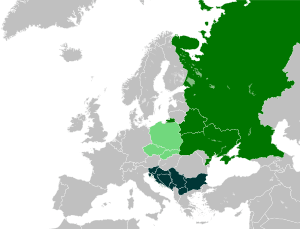Krashovani
The Krashovani (Romanian: Carașoveni, Serbo-Croatian: Krašovani) are a South Slavic community inhabiting Carașova and Lupac in the Caraș-Severin County within Romanian Banat. They are regarded as and predominantly self-identify as Croats. They are Roman Catholic by faith and speak the Torlakian dialect. Glottolog lists "Karashevski" as sub-type of Croatian language. [1]
| Total population | |
|---|---|
| 5,000, most declare themselves as Croats, some as Krashovani | |
| Regions with significant populations | |
| Languages | |
| Croatian, Romanian | |
| Religion | |
| Predominantly Roman Catholic | |
| Related ethnic groups | |
| Croats of Romania, Serbs of Romania |

Names
In Romanian, they are commonly known as "Carașoveni"; other variants include Carșoveni, Cârșoveni, Cotcoreți or Cocoși. In Serbo-Croatian, they are commonly known as "Krašovani"; other variants include Karašovani, Krašovanje, Karaševci and Koroševci.
Settlements
Krashovani, declared as Croats, form a majority in two communes of Caraș-Severin County: Carașova and Lupac.
- Carașova commune
- Carașova (Krašovo)
- Nermed (Nermet)
- Iabalcea (Jablča)
- Lupac commune
- Clocotici (Klokotić)
- Rafnic (Ravnik)
- Vodnic (Vodnik)
- Lupac (Lupak)
Identity
The Krashovani are Serbo-Croatian speakers adhering to the Catholic Church.[2] Their dialect is regarded a sub-dialect of the Torlak dialect,[3] a transitional dialect spoken in southeastern Serbia, westernmost Bulgaria and northeastern Macedonia.
According to the 2002 census in Romania, the population of the Carașova commune comprised 84.60% Croats, 4.96% others, 4.47% Roma, 4.41% Romanians and others.[4] 93.12% of the population in that commune declared their mother tongue as Croatian.[4] Only 207 persons declared Krashovani ethnicity in the 2002 census.[5]
History
Their ancestors first settled Carașova in the 13th and 14th centuries from northwestern Bosnia.[6] They formed a community in the northern plateau of the Caraș river, in seven villages, the oldest, Carașova, being mentioned in the 13th and 14th centuries while the rest are first mentioned in the 17th century.[6]
Serbian ethnographer Jovan Cvijić concluded that the community was "very old settlers with origin in Crna Reka who were Catholicised"; Stanko Žuljić claims that their origin is in Turopolje, in Croatia.[7]
The Carașoveni were considered Bulgarians by some Bulgarian scientists in the first half of the 20th century (such as G. Cibrus, M. Mladenov, K. Telbizov, and T. Balkanski), partially based on their view that Torlakian-speakers are ethnically Bulgarians.
According to the Austrian population census there were over 10,000 Carașoveni in Banat. In the 1847 census over 10,000 people declared as Carașoveni. In 1896 the Austro-Hungarian census around 7,500 Carașoveni were listed. The same was stated by the authorities of the Kingdom of Romania in 1940. Their number dropped to 2,775 in 1992.[8]
Ever since the Romanian Revolution, the government of Romania has awarded special minority status and privileges to its ethnic Serb citizens. The Democratic Union of Serbs and Krashovani of Romania (Uniunea Democratică a Sârbilor si Carașovenilor din România) was founded in 1992.
See also
- Torlakian dialect
- Minorities of Romania
- Serbs in Romania
- Banat Bulgarians
- Lupac
References
- http://glottolog.org/resource/languoid/id/kara1507
- Гласник Етнографског института. 42-43. Научно дело. 1993. p. 11.
- Dalibor Brozović (1999). Hrvatska enciklopedija: O-Pre. Leksikografski zavod "Miroslav Krleža". p. 675. ISBN 978-953-6036-29-5.
- "Structura etno-demografică pe arii geografice: Carașova". Ethnocultural Diversity Resource Center.
- (in Romanian) Recensământ 2002. Rezultate: Populaţia după etnie la recensământul din 2002 Archived March 25, 2008, at the Wayback Machine; retrieved November 10, 2007
- Marius Rotar; Adriana Teodorescu; Corina Rotar (17 March 2014). Dying and Death in 18th-21st Century Europe: Volume 2. Cambridge Scholars Publishing. pp. 19–. ISBN 978-1-4438-5746-8.
- Stanko Žuljić (1997). Srpski etnos i velikosrpstvo. AGM. pp. 110, 274.
- Spațiul istoric și etnic românesc, Vol.I, Editura Militară, Bucharest, 1992
